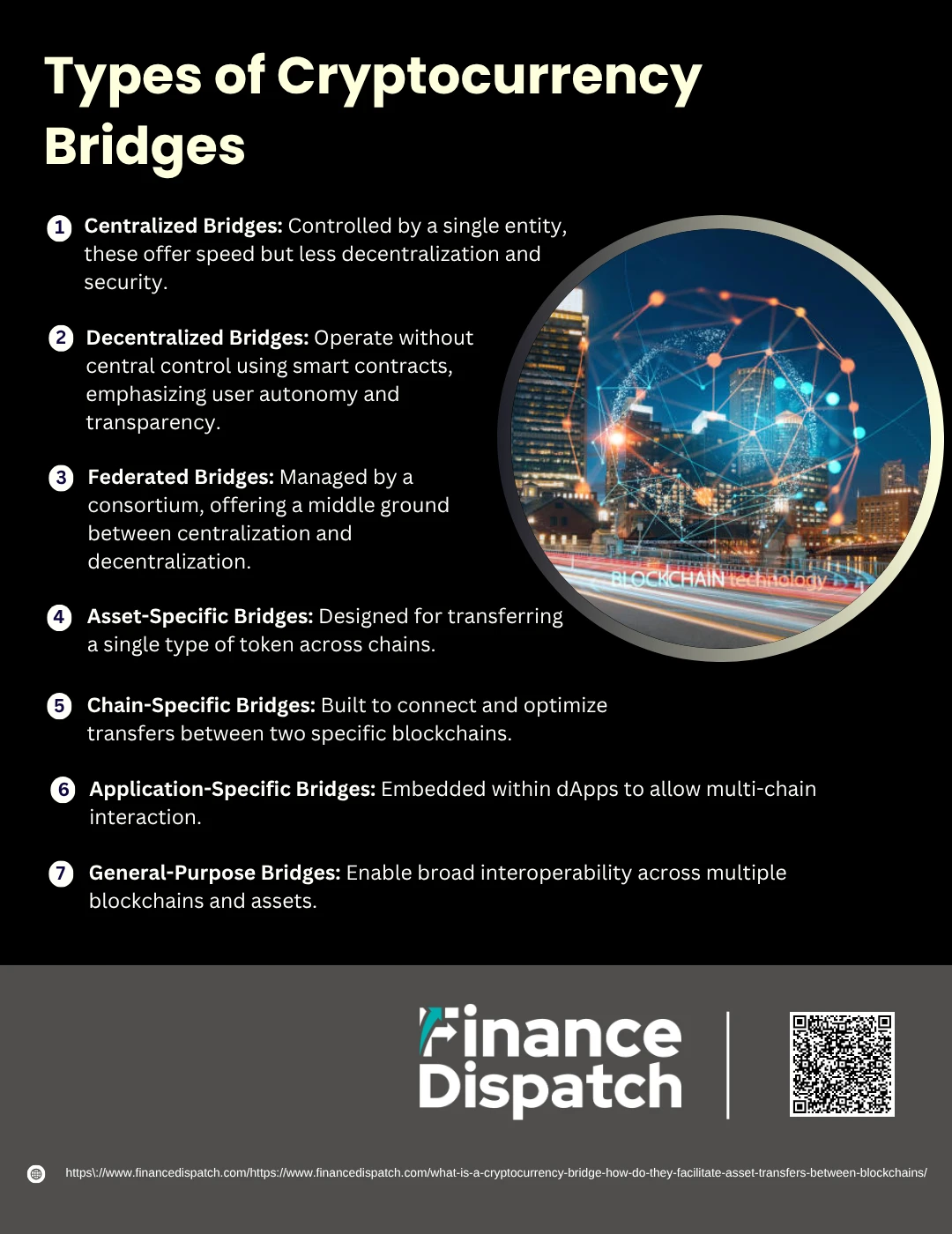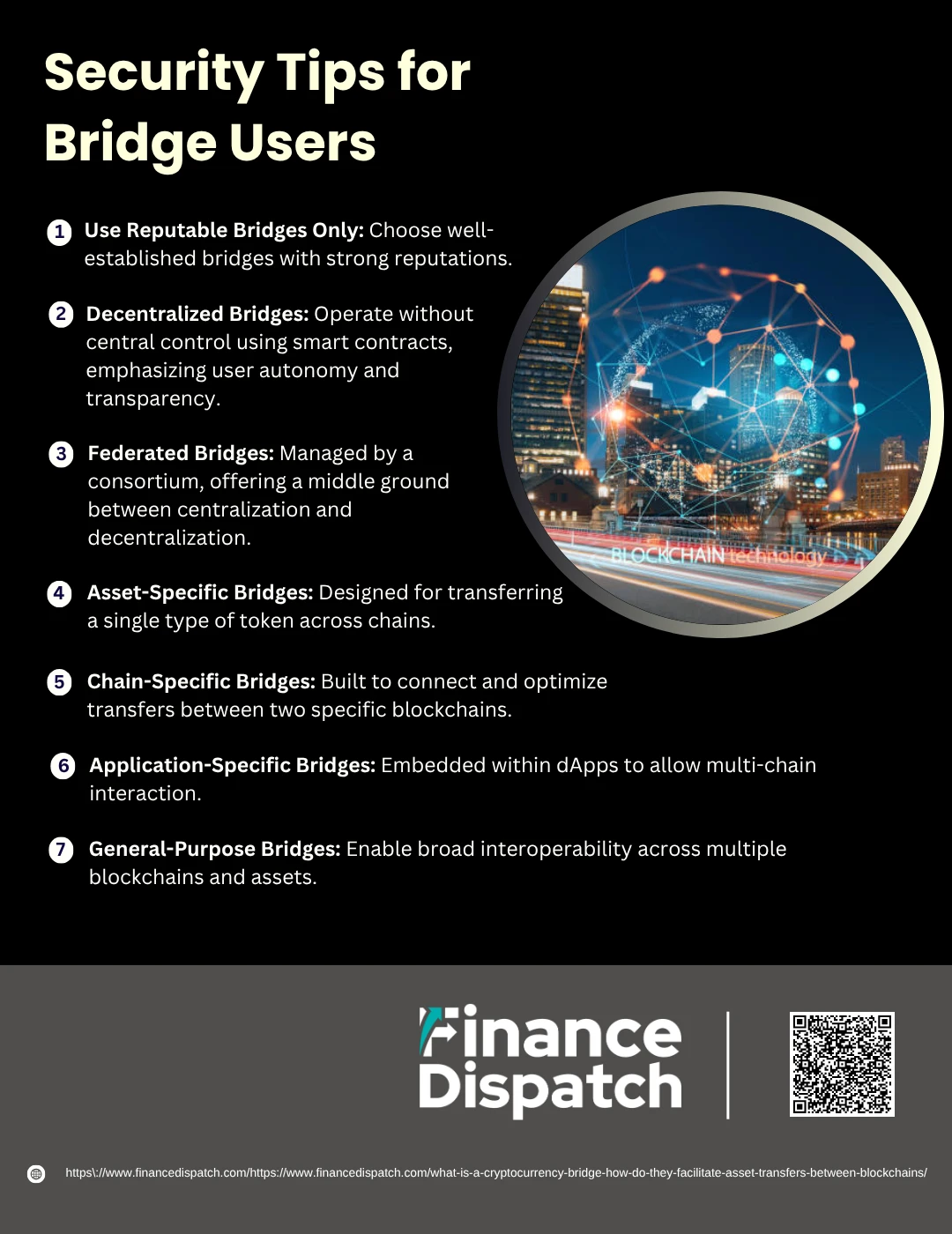In the ever-expanding world of blockchain, different networks like Ethereum, Solana, and Binance Smart Chain often operate in isolation, making it difficult to move assets between them. This lack of interoperability limits user access to decentralized applications and financial opportunities spread across various ecosystems. Enter cryptocurrency bridges—innovative protocols designed to connect these separate blockchains. By enabling seamless asset and data transfers, these bridges are transforming the way users interact with crypto networks, unlocking a more flexible and interconnected digital economy.
What is a Cryptocurrency Bridge?
A cryptocurrency bridge is a protocol or platform that enables the transfer of digital assets and data between two separate blockchain networks. Since most blockchains are built with unique protocols and operate independently, they are not inherently compatible with one another. A bridge solves this problem by acting as a conduit that allows users to move tokens from one blockchain to another without relying on centralized exchanges. For example, if you want to use your Bitcoin on Ethereum’s DeFi platforms, a bridge can lock your BTC on the Bitcoin network and mint an equivalent wrapped token, such as WBTC, on Ethereum. This process maintains the value of the original asset while granting access to applications on a different blockchain.
Why Are Cryptocurrency Bridges Important?
Cryptocurrency bridges are important because they enable interoperability in a fragmented blockchain ecosystem. Without bridges, assets are confined to their native blockchains, limiting users’ ability to access decentralized applications, liquidity pools, and financial services available on other networks. Bridges break down these barriers by allowing seamless movement of tokens across chains, which expands user flexibility and promotes greater participation in decentralized finance (DeFi). They also help reduce dependency on centralized exchanges, enhance transaction efficiency, and unlock the full potential of each blockchain’s unique features. In essence, bridges are the key to building a more connected and functional blockchain landscape.
 How Do They Facilitate Asset Transfers Between Blockchains?
How Do They Facilitate Asset Transfers Between Blockchains?
Cryptocurrency bridges play a critical role in enabling users to move tokens between separate blockchain networks. Since these networks often use different protocols and are not natively compatible, direct asset transfers are impossible. Bridges solve this problem by using mechanisms like asset locking, minting of wrapped tokens, and cross-chain verification to mirror the value of one asset on another blockchain. Below is a step-by-step explanation of how this process typically unfolds:
1. Initiation of Transfer
The process begins when a user accesses a bridge interface (such as a website or dApp) and connects their cryptocurrency wallet. The user then selects the asset they want to transfer, the originating blockchain, and the destination blockchain. This step involves confirming the amount to be transferred and authorizing the transaction to initiate the bridging process.
2. Locking or Burning of Assets
Once the transaction is approved, the bridge protocol locks the original asset in a smart contract on the source blockchain. In some cases, instead of locking, the tokens may be burned—meaning they are permanently removed from circulation. This step is essential because it ensures that the asset is no longer spendable on the source chain while its equivalent is being created on the destination chain.
3. Verification of Transaction
After the assets are locked or burned, the bridge must verify that this action has occurred correctly. This is typically done through a network of validators, oracles, or smart contracts that monitor both blockchains. The goal here is to confirm the legitimacy and finality of the transaction before proceeding to the next step. This helps maintain the integrity and security of the bridging process.
4. Minting or Releasing Wrapped Tokens
Upon successful verification, the bridge issues a new token on the destination blockchain. This is often a “wrapped” version of the original asset—such as Wrapped Bitcoin (WBTC) on Ethereum, which represents BTC. The new token maintains a 1:1 value peg with the original asset. In some bridges, if the token already exists in a liquidity pool, the equivalent amount is simply released from that pool rather than minted.
5. Use on Destination Chain
The user now receives the wrapped token in their wallet on the destination chain. These tokens are fully usable within the ecosystem of the target blockchain. For instance, the user can stake them in DeFi platforms, provide liquidity, trade on decentralized exchanges, or purchase NFTs. The wrapped tokens behave like any other native token of that chain while maintaining their value equivalence with the original asset.
6. Redeeming Original Assets (Optional)
If the user wants to return the asset to its original chain, they can initiate a reverse process. The wrapped tokens are either burned or locked on the destination blockchain. Once this is verified, the bridge unlocks the previously held original asset on the source blockchain and sends it back to the user’s wallet. This ensures that the total supply remains balanced and prevents duplication of assets across chains.
Core Characteristics of Crypto Bridges
Crypto bridges are more than just tools for transferring assets—they’re fundamental infrastructure that enable interoperability across otherwise isolated blockchain networks. Their unique features not only make cross-chain interactions possible but also enhance the efficiency, utility, and decentralization of the crypto ecosystem. Below are the core characteristics that define how these bridges function and why they matter:
1. Interoperability
Crypto bridges allow different blockchains to communicate, enabling the transfer of tokens and data across platforms that were not originally designed to work together.
2. Utility Extension
They extend the usefulness of digital assets by allowing them to be deployed on new blockchains. This means a token like BTC can participate in Ethereum-based DeFi, expanding its functional value.
3. Transaction Simplification
Without bridges, moving assets across chains would require multiple steps, often involving centralized exchanges. Bridges reduce this to a single, user-friendly operation.
4. Decentralization
Many bridges are non-custodial, meaning they don’t rely on a central authority. They use smart contracts to enforce rules and execute transfers, giving users more control over their assets.
5. Speed and Efficiency
Bridges streamline cross-chain processes, enabling near-instant transfers compared to the more time-consuming traditional methods involving multiple exchanges.
7. Security Through Smart Contracts
Properly designed bridges rely on audited and transparent smart contracts that automate processes securely, though they still require cautious use to avoid exploit risks.
8. Support for Wrapped Assets
Bridges create wrapped versions of native tokens on the destination blockchain, ensuring value parity while enabling cross-chain usability.
 Types of Cryptocurrency Bridges
Types of Cryptocurrency Bridges
Not all cryptocurrency bridges are built the same. Depending on their architecture, trust model, and purpose, different types of bridges offer varied levels of security, decentralization, speed, and compatibility. Understanding the major types of crypto bridges is essential for users who want to choose the right option for their specific cross-chain needs. Below are the primary types of cryptocurrency bridges explained in detail:
1. Centralized Bridges
These are controlled by a single authority or organization. Users must trust this entity to manage asset transfers securely and honestly. Centralized bridges may offer faster transactions and support a wider range of assets, but they come with the risks of censorship, custodial control, and potential single points of failure.
2. Decentralized Bridges
Also known as non-custodial bridges, these rely on smart contracts and automated systems rather than a central authority. They prioritize user control and transparency but may be slower or costlier due to network congestion and complex consensus mechanisms.
3. Federated Bridges
These bridges are operated by a group of known and trusted entities, referred to as a federation. Each member of the federation helps validate transactions. Federated bridges strike a balance between centralization and decentralization, offering improved efficiency while reducing the risks of single-party control.
4. Asset-Specific Bridges
Designed to support only one type of asset, these bridges focus on moving a specific token between two blockchains. For example, a bridge that only transfers Bitcoin to Ethereum by creating wrapped BTC (WBTC) on the Ethereum network.
5. Chain-Specific Bridges
These bridges are built to connect two specific blockchains, enabling transfers between them. They are optimized for those networks and may offer faster performance, but lack broader flexibility with other chains.
6. Application-Specific Bridges
These bridges are integrated within specific decentralized applications (dApps). They allow the dApp to interact with multiple blockchains, often to improve user experience or access liquidity on different networks.
7. General-Purpose Bridges
Built for broader interoperability, general-purpose bridges can connect multiple blockchains and transfer various types of tokens or data. They often serve as foundational infrastructure for large multi-chain ecosystems like Cosmos or Polkadot.
Real-World Applications of Crypto Bridges
Crypto bridges are more than theoretical tools—they are actively shaping how users and developers interact across blockchain ecosystems. By enabling the transfer of tokens and data between otherwise incompatible chains, bridges open the door to new possibilities in decentralized finance, digital art, and beyond. Here are some of the most impactful real-world applications of crypto bridges:
1. Cross-Chain DeFi Participation
Users can bridge assets like BTC to Ethereum to engage in DeFi protocols such as lending, staking, and yield farming that are not available on Bitcoin’s native blockchain.
2. NFT Transfers Across Ecosystems
Creators can mint NFTs on Ethereum and sell or trade them on platforms built on other chains like Binance Smart Chain or Polygon, reaching broader markets with lower fees.
3. Optimizing Liquidity and Yield
Investors move assets across blockchains to access liquidity pools with better returns or lower risk, enhancing their DeFi yield strategies.
4. Arbitrage Opportunities
Traders can quickly shift funds between blockchains to exploit price differences of the same asset on different decentralized exchanges.
5. Access to Lower Transaction Costs
Users bridge assets from high-fee blockchains (e.g., Ethereum) to more efficient ones (e.g., Solana or Arbitrum) to benefit from faster and cheaper transactions.
6. Decentralized Gaming and Metaverse Interactions
In blockchain games and metaverse platforms, bridges allow users to transfer in-game assets or currencies across multiple ecosystems for broader utility.
7. Supporting Multi-Chain dApps
Developers use bridges to create decentralized applications that operate across multiple blockchains, offering users more flexibility and reducing fragmentation.
Crypto Bridges vs. Exchanges and Wrapping
When transferring assets across blockchains, users often face multiple options: using a crypto bridge, relying on centralized exchanges, or utilizing wrapped tokens. While all these methods aim to increase asset mobility and interoperability, they differ significantly in approach, trust requirements, and user experience. Understanding the distinctions between these methods is essential for making informed decisions in the decentralized ecosystem.
| Feature | Crypto Bridges | Centralized Exchanges | Wrapped Tokens |
| Purpose | Move assets directly between blockchains | Convert assets via fiat or other crypto | Represent assets on non-native blockchains |
| Trust Model | Often decentralized, trustless (varies) | Requires trust in the exchange | Requires trust in the wrapping protocol |
| User Control | Maintains control via wallets | Funds are temporarily held by the exchange | Custody depends on the wrapping system |
| Decentralization | High (for non-custodial bridges) | Low | Medium to Low (varies by protocol) |
| Speed | Moderate to High | High | Fast once wrapped token exists |
| Cost | Varies by network and bridge used | May include trading and withdrawal fees | Network fees plus minting/burning costs |
| Use Cases | DeFi access, yield farming, NFTs | Trading, onboarding/offboarding | Cross-chain utility in dApps and DeFi |
| Security Risks | Smart contract vulnerabilities | Custodial risk, exchange hacks | Mismanagement or failure of custodian |
Risks and Challenges of Using Bridges
While crypto bridges offer powerful functionality by enabling cross-chain asset transfers, they also introduce a range of risks that users must carefully consider. These bridges rely on smart contracts, third-party validators, and often complex infrastructure, which can expose vulnerabilities. Whether centralized or decentralized, every type of bridge carries trade-offs in terms of security, cost, and reliability. Here are some of the key risks and challenges associated with using crypto bridges:
1. Smart Contract Vulnerabilities
Bugs or exploits in bridge contracts can be targeted by hackers, leading to significant losses. Several high-profile bridge hacks have exposed these risks.
2. Phishing and Fake Bridge Interfaces
Malicious actors often create fake bridge websites with URLs similar to legitimate ones, tricking users into connecting wallets and losing funds.
3. Centralization Risks
Some bridges, especially custodial or federated ones, rely on trusted parties to hold or manage funds. This creates single points of failure and reduces transparency.
4. Loss of Asset Custody
During the bridging process, assets are locked or controlled by a smart contract or intermediary, meaning users temporarily lose direct access to their funds.
5. Incompatibility and Limited Support
Not all tokens or chains are supported by every bridge, and attempting unsupported transfers can result in failed transactions or lost assets.
6. Transaction Delays and Network Congestion
Bridge transfers can sometimes take longer than expected, especially during high network traffic, leading to delays or increased transaction fees.
7. Regulatory Uncertainty
As bridges handle high-value transfers across decentralized systems, they are increasingly scrutinized by regulators, which could impact access or usage in the future.
 Security Tips for Bridge Users
Security Tips for Bridge Users
Crypto bridges offer a powerful way to unlock cross-chain utility, but they also carry risks—from technical flaws to human error. Because these tools interact with complex smart contracts and manage high-value transfers across different blockchains, they are frequent targets for phishing, exploits, and misconfigurations. Fortunately, users can reduce their exposure to these threats by following practical security measures. Below is an expanded list of essential tips to help you use crypto bridges safely and confidently:
1. Use Reputable Bridges Only
Stick to well-known, widely adopted bridges with transparent teams and proven track records. Avoid using newly launched or obscure bridges unless you’ve done thorough research.
2. Verify URLs and Interfaces
Scammers often create fake websites that look nearly identical to real ones. Always check for typos in the domain name and only access bridge platforms through official project links shared on trusted sources like CoinGecko, CoinMarketCap, or the project’s verified social media.
3. Start with Small Transactions
Testing with a small amount can help you confirm the bridge functions properly and avoid major losses if something goes wrong. This is especially important when interacting with a new blockchain or wallet for the first time.
4. Read the Documentation
Every bridge has unique rules, supported assets, and limitations. Reading the official documentation can help you understand things like transfer times, gas fees, refund policies, and whether your wallet is compatible.
5. Check for Audit Reports
Smart contracts are the backbone of most decentralized bridges. Look for public audit reports by respected firms (like Certik, Trail of Bits, or PeckShield) to ensure the code has been reviewed for security flaws.
6. Keep Wallets Secure
Use trusted, non-custodial wallets such as MetaMask, Rabby, or hardware wallets like Ledger or Trezor. Never enter your private key or seed phrase on a bridge site—no legitimate platform will ever ask for them.
7. Monitor Gas Fees and Network Status
Network congestion can delay transactions and increase costs. Before bridging, use tools like Etherscan or GasNow to check current gas prices. Some bridges may also charge additional fees for execution, so be sure to review total costs.
8. Stay Updated on Exploits and Bugs
Follow the official communication channels of the bridge project (Telegram, Discord, X/Twitter) to stay informed about potential bugs, security incidents, or important protocol updates. Being informed helps you act quickly if something goes wrong.
The Future of Cryptocurrency Bridges
As blockchain ecosystems continue to expand and diversify, the role of cryptocurrency bridges is becoming increasingly central to achieving full interoperability. Future developments in bridge technology are expected to focus on enhancing security, improving scalability, and minimizing user complexity. Innovations like trust-minimized bridges, zero-knowledge proofs, and cross-chain messaging protocols are being explored to reduce vulnerabilities and increase efficiency. Projects such as Polkadot and Cosmos are already pushing the boundaries by enabling native interoperability through shared infrastructure. Additionally, as the regulatory landscape evolves, bridges may need to incorporate compliance features without compromising decentralization. Ultimately, the future of crypto bridges lies in building seamless, secure, and scalable pathways that unify the fragmented blockchain space into a more connected and user-friendly ecosystem.
Conclusion
Cryptocurrency bridges have emerged as vital infrastructure in the evolving blockchain ecosystem, enabling seamless asset and data transfers across networks that were once isolated. By solving the problem of interoperability, these bridges empower users to tap into the best features of multiple blockchains—whether it’s accessing DeFi opportunities, reducing transaction costs, or enhancing liquidity strategies. While they offer immense utility, bridges also come with risks that demand careful attention and informed usage. As technology advances, the continued development of secure, efficient, and decentralized bridges will be key to unlocking a truly interconnected crypto landscape.



